选修8课文翻译--全析
英语选修八全部课文翻译
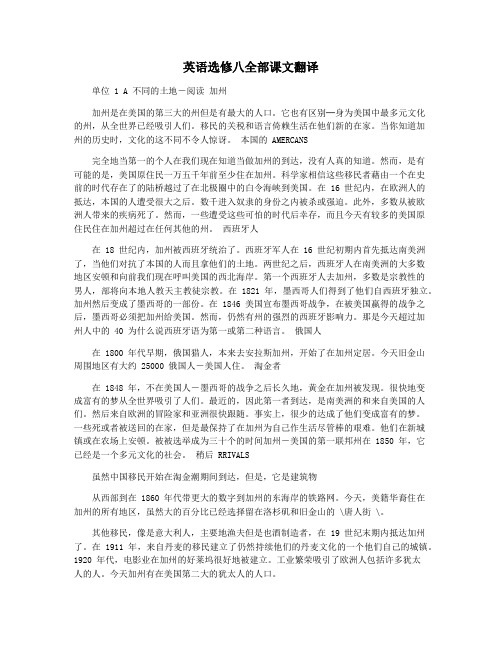
英语选修八全部课文翻译单位 1 A 不同的土地-阅读加州加州是在美国的第三大的州但是有最大的人口。
它也有区别─身为美国中最多元文化的州,从全世界已经吸引人们。
移民的关税和语言倚赖生活在他们新的在家。
当你知道加州的历史时,文化的这不同不令人惊讶。
本国的 AMERCANS完全地当第一的个人在我们现在知道当做加州的到达,没有人真的知道。
然而,是有可能的是,美国原住民一万五千年前至少住在加州。
科学家相信这些移民者藉由一个在史前的时代存在了的陆桥越过了在北极圈中的白令海峡到美国。
在 16 世纪内,在欧洲人的抵达,本国的人遭受很大之后。
数千进入奴隶的身份之内被杀或强迫。
此外,多数从被欧洲人带来的疾病死了。
然而,一些遭受这些可怕的时代后幸存,而且今天有较多的美国原住民住在加州超过在任何其他的州。
西班牙人在 18 世纪内,加州被西班牙统治了。
西班牙军人在 16 世纪初期内首先抵达南美洲了,当他们对抗了本国的人而且拿他们的土地。
两世纪之后,西班牙人在南美洲的大多数地区安顿和向前我们现在呼叫美国的西北海岸。
第一个西班牙人去加州,多数是宗教性的男人,部将向本地人教天主教徒宗教。
在 1821 年,墨西哥人们得到了他们自西班牙独立。
加州然后变成了墨西哥的一部份。
在 1846 美国宣布墨西哥战争,在被美国嬴得的战争之后,墨西哥必须把加州给美国。
然而,仍然有州的强烈的西班牙影响力。
那是今天超过加州人中的 40 为什么说西班牙语为第一或第二种语言。
俄国人在 1800 年代早期,俄国猎人,本来去安拉斯加州,开始了在加州定居。
今天旧金山周围地区有大约 25000 俄国人-美国人住。
淘金者在 1848 年,不在美国人-墨西哥的战争之后长久地,黄金在加州被发现。
很快地变成富有的梦从全世界吸引了人们。
最近的,因此第一者到达,是南美洲的和来自美国的人们。
然后来自欧洲的冒险家和亚洲很快跟随。
事实上,很少的达成了他们变成富有的梦。
一些死或者被送回的在家,但是最保持了在加州为自己作生活尽管棒的艰难。
人教版英语选修8课文原文及课文译文

人教版英语选修8课文原文及课文译文Unit 1 Aland of diversity 第一单元一个多元文化的国土ReadingCALIFORNIACalifornia is the third largest state in the USA but has the largest population. It also has the distinction of being the most multicultural state in the USA, having attracted people from all over the world. The customs and languages of the immigrants live on in their new home. This diversity of culture is not surprising when you know the history of California. NATIVE AMERCANSIn the 18th century California was ruled by Spain. Spanish soldiers first arrived in South America in the early 16th century, when they fought against the native people and took their land. Two centuries later, the Spanish had settled in most parts of South America and along the northwest coast of what we now call the United States. Of the first Spanish to go to California, the majority were religious men, whose ministry was to teach the Catholic religion to the natives. In 1821, the people of Me某ico gained their independence from Spain. California then became part of Me某ico. In 1846 the United States declared war on Me某ico, and after the war won by the USA, Me某ico had to give California to the USA. However, thereis still a strong Spanish influence in the state. That is why today over 40 of Californians speak Spanish as a first or second language. RUSSIANSIn the early 1800s, Russian hunters, who had originally gone to Alaska, began settling in California. Today there are about 25,000 Russian-Americans living in and around San Francisco. GOLD MINERSAlthough Chinese immigrants began to arrive during the Gold Rush Period, it was the building of the rail network from the west to the east coast that brought even larger numbers to California in the 1860s. Today, Chinese-Americans live in all parts of California, although a large percentage have chosen to stay in the \Other immigrants such as Italians, mainly fishermen but also wine makers, arrived in California in the late 19th century. In 1911 immigrants from Denmark established a town of their own, which today still keeps up their Danish culture. By the 1920s the film industry was well established in Hollywood, California. The industry boom attracted Europeans including many Jewish people. Today California has the second largest Jewish population in the United States.Japanese farmers began arriving in California at the beginning of the 20th century, and since the 1980s a lot more have settled there. People from Africa have been living in California since the 1800s, when they moved north from Me某ico. However, even more arrived between 1942 and 1945to work in the ship and aircraft industries. MOST RECENT ARRIVALSCalifornia. THE FUTUREPeople from different parts of the world, attracted by the climate and the lifestyle, still immigrate to California. It is believed that before long the mi某 of nationalities will be so great that there will be no distinct major racial or cultural groups, but simply a mi某ture of many races and cultures.加利福尼亚加利福尼亚是美国的第三大州,而且是人口最多的州。
高中英语人教版选修8翻译课文翻译
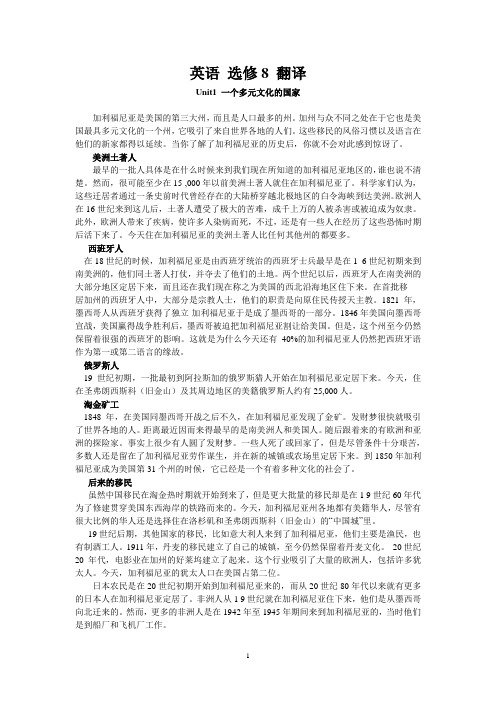
英语选修8 翻译Unit1 一个多元文化的国家加利福尼亚是美国的第三大州,而且是人口最多的州。
加州与众不同之处在于它也是美国最具多元文化的一个州,它吸引了来自世界各地的人们。
这些移民的风俗习惯以及语言在他们的新家都得以延续。
当你了解了加利福尼亚的历史后,你就不会对此感到惊讶了。
美洲土著人最早的一批人具体是在什么时候来到我们现在所知道的加利福尼亚地区的,谁也说不清楚。
然而,很可能至少在15 ,000年以前美洲土著人就住在加利福尼亚了。
科学家们认为,这些迁居者通过一条史前时代曾经存在的大陆桥穿越北极地区的白令海峡到达美洲。
欧洲人在16世纪来到这儿后,土著人遭受了极大的苦难,成千上万的人被杀害或被迫成为奴隶。
此外,欧洲人带来了疾病,使许多人染病而死,不过,还是有一些人在经历了这些恐怖时期后活下来了。
今天住在加利福尼亚的美洲土著人比任何其他州的都要多。
西班牙人在18世纪的时候,加利福尼亚是由西班牙统治的西班牙士兵最早是在1 6世纪初期来到南美洲的,他们同土著人打仗,并夺去了他们的土地。
两个世纪以后,西班牙人在南美洲的大部分地区定居下来,而且还在我们现在称之为美国的西北沿海地区住下来。
在首批移居加州的西班牙人中,大部分是宗教人士,他们的职责是向原住民传授天主教。
1821年,墨西哥人从西班牙获得了独立-加利福尼亚于是成了墨西哥的一部分。
1846年美国向墨西哥宣战,美国赢得战争胜利后,墨西哥被迫把加利福尼亚割让给美国。
但是,这个州至今仍然保留着很强的西班牙的影响。
这就是为什么今天还有40%的加利福尼亚人仍然把西班牙语作为第一或第二语言的缘故。
俄罗斯人19世纪初期,一批最初到阿拉斯加的俄罗斯猎人开始在加利福尼亚定居下来。
今天,住在圣弗朗西斯科(旧金山)及其周边地区的美籍俄罗斯人约有25,000人。
淘金矿工1848年,在美国同墨西哥开战之后不久,在加利福尼亚发现了金矿。
发财梦很快就吸引了世界各地的人。
距离最近因而来得最早的是南美洲人和美国人。
最新人教版高中英语选修8 课文及翻译
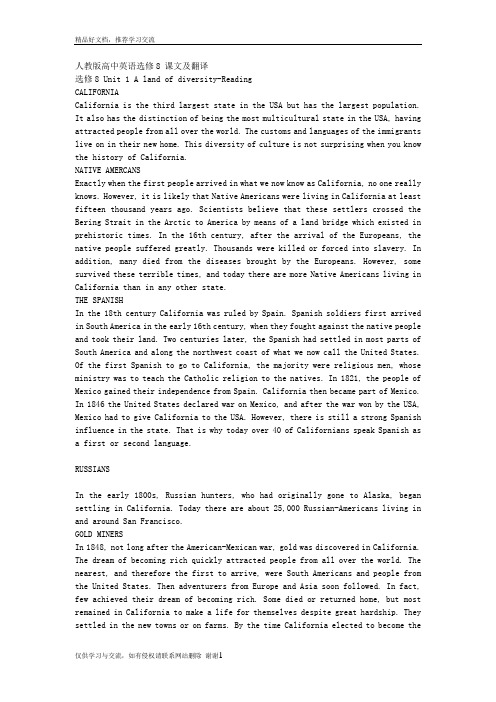
人教版高中英语选修8 课文及翻译选修8 Unit 1 A land of diversity-ReadingCALIFORNIACalifornia is the third largest state in the USA but has the largest population. It also has the distinction of being the most multicultural state in the USA, having attracted people from all over the world. The customs and languages of the immigrants live on in their new home. This diversity of culture is not surprising when you know the history of California.NATIVE AMERCANSExactly when the first people arrived in what we now know as California, no one really knows. However, it is likely that Native Americans were living in California at least fifteen thousand years ago. Scientists believe that these settlers crossed the Bering Strait in the Arctic to America by means of a land bridge which existed in prehistoric times. In the 16th century, after the arrival of the Europeans, the native people suffered greatly. Thousands were killed or forced into slavery. In addition, many died from the diseases brought by the Europeans. However, some survived these terrible times, and today there are more Native Americans living in California than in any other state.THE SPANISHIn the 18th century California was ruled by Spain. Spanish soldiers first arrived in South America in the early 16th century, when they fought against the native people and took their land. Two centuries later, the Spanish had settled in most parts of South America and along the northwest coast of what we now call the United States. Of the first Spanish to go to California, the majority were religious men, whose ministry was to teach the Catholic religion to the natives. In 1821, the people of Mexico gained their independence from Spain. California then became part of Mexico. In 1846 the United States declared war on Mexico, and after the war won by the USA, Mexico had to give California to the USA. However, there is still a strong Spanish influence in the state. That is why today over 40 of Californians speak Spanish as a first or second language.RUSSIANSIn the early 1800s, Russian hunters, who had originally gone to Alaska, began settling in California. Today there are about 25,000 Russian-Americans living in and around San Francisco.GOLD MINERSIn 1848, not long after the American-Mexican war, gold was discovered in California. The dream of becoming rich quickly attracted people from all over the world. The nearest, and therefore the first to arrive, were South Americans and people from the United States. Then adventurers from Europe and Asia soon followed. In fact, few achieved their dream of becoming rich. Some died or returned home, but most remained in California to make a life for themselves despite great hardship. They settled in the new towns or on farms. By the time California elected to become thethirty-first federal state of the USA in 1850, it was already a multicultural society.LATER A RRIVALSAlthough Chinese immigrants began to arrive during the Gold Rush Period, it was the building of the rail network from the west to the east coast that brought even larger numbers to California in the 1860s. Today, Chinese-Americans live in all parts of California, although a large percentage have chosen to stay in the "Chinatowns" of Los Angeles and San Francisco.Other immigrants such as Italians, mainly fishermen but also wine makers, arrived in California in the late 19th century. In 1911 immigrants from Denmark established a town of their own, which today still keeps up their Danish culture. By the 1920s the film industry was well established in Hollywood, California. The industry boom attracted Europeans including many Jewish people. Today California has the second largest Jewish population in the United States.Japanese farmers began arriving in California at the beginning of the 20th century, and since the 1980s a lot more have settled there. People from Africa have been living in California since the 1800s, when they moved north from Mexico. However, even more arrived between 1942 and 1945 to work in the ship and aircraft industries. MOST RECENT ARRIVALSIn more recent decades, California has become home to more people from Asia, including Koreans, Cambodians, Vietnamese and Laotians. Since its beginning in the 1970s, the computer industry has attracted Indians and Pakistanis to California. THE FUTUREPeople from different parts of the world, attracted by the climate and the lifestyle, still immigrate to California. It is believed that before long the mix of nationalities will be so great that there will be no distinct major racial or cultural groups, but simply a mixture of many races and cultures.GEORGE’S DIARY 12TH—14TH JUNEMonday 12th, JuneArrived early this morning by bus. Went straight to hotel to drop my luggage, shower and shave. Then went exploring. First thing was a ride on a cable car. From top of the hill got a spectacular view of San Francisco Bay and the city. Built in 1873, the cable car system was invented by Andrew Hallidie, who wanted to find a better form of transport than horse-drawn trams. Apparently he'd been shocked when he saw a terrible accident in which a tram's brakes failed, the conductor could not control the situation and the tram slipped down the hill dragging the horses with it. Had a late lunch at Fisherman's What. This is the district where Italian fishermen first came to San Francisco in the late 19th century and began the fishing industry. Now it's a tourist area with lots of shops, sea food restaurants and bakeries. It's also the place to catch the ferry to Angel Island and other places in the Bay.Did so much exploring at Fisherman's What. Am exhausted and don't feel like doing anything else. Early bed tonight!Tuesday 13th, JuneTeamed up with a couple from my hotel (Peter and Terri) and hired a car. Spent all day driving around the city. There's a fascinating drive marked out for tourists. It has blue and white signs with seagulls on them to show the way to go. It's a 79km round-trip that takes in all the famous tourist spots. Stopped many times to admire the view of the city from different angles and take photographs. Now have a really good idea of what the city's like.In evening, went to Chinatown with Peter and Terri. Chinese immigrants settled in this area in the 1850s. The fronts of the buildings are decorated to look like old buildings in southern China. Saw some interesting temples here, a number of markets and a great many restaurants. Also art galleries and a museum containing documents, photographs and all sorts of objects about the history of Chinese immigration, but it is closed in the evening. Will go back during the day. Had a delicious meal and then walked down the hill to our hotel.Wednesday 14th, JuneIn morning, took ferry to Angel Island from the port in San Francisco Bay. On the way had a good view of the Golden Gate Bridge. From 1882 to 1940 Angel Island was a famous immigration station where many Chinese people applied for right to live in USA. The cells in the station were very small, cold and damp; some did not even have light but the immigrants had nowhere else to go. Their miserable stay seemed to be punishment rather than justice and freedom to them. They wrote poems on the walls about their loneliness and mourned their former life in China. In 1940 the civil authorities reformed the system so that many more Chinese people were able to grasp the opportunity of settling in the USA. Made me very thoughtful and thankful for my life today.选修8 Unit 2 Cloning-ReadingCLONING: WHERE IS IT LEADING US?Cloning has always been with us and is here to stay. It is a way of making an exact copy of another animal or plant. It happens in plants when gardeners take cuttings from growing plants to make new ones. It also happens in animals when twins identical in sex and appearance are produced from the same original egg. The fact is that these are both examples of natural clones.Cloning has two major uses. Firstly, gardeners use it all the time to produce commercial quantities of plants. Secondly, it is valuable for research on new plant species and for medical research on animals. Cloning plants is straightforward while cloning animals is very complicated. It is a difficult task to undertake. Many attempts to clone mammals failed. But at last the determination and patience of the scientists paid off in 1996 with a breakthrough - the cloning of Dolly the sheep.The procedure works like this:On the one hand, the whole scientific world followed the progress of the first successful clone, Dolly the sheep. The fact that she seemed to develop normally was very encouraging. Then came the disturbing news that Dolly had become seriously ill. Cloning scientists were cast down to find that Dolly's illnesses were more appropriate to a much older animal. Altogether Dolly lived six and a half years, half the length of the life of the original sheep. Sadly the same arbitrary fate affected other species, such as cloned mice. The questions that concerned all scientists were: "Would this be a major difficulty for all cloned animals? Would it happen forever? Could it be solved if corrections were made in their research procedure?"On the other hand, Dolly's appearance raised a storm of objections and had a great impact on the media and public imagination. It became controversial. It suddenly opened everybody's eyes to the possibility of using cloning to cure serious illnesses and even to produce human beings.Although at present human egg cells and embryos needed for cloning research are difficult to obtain, newspapers wrote of evil leaders hoping to clone themselves to attain their ambitions. Religious leaders also raised moral questions. Governments became nervous and more conservative. Some began to reform their legal systems and forbade research into human cloning, but other countries like China and the UK, continued to accumulate evidence of the abundant medical aid that cloning could provide. However, scientists still wonder whether cloning will help or harm us and where it is leading us.克隆一直在我们左右并且已经被大多数人接受。
人教版高中英语选修8 课文及翻译
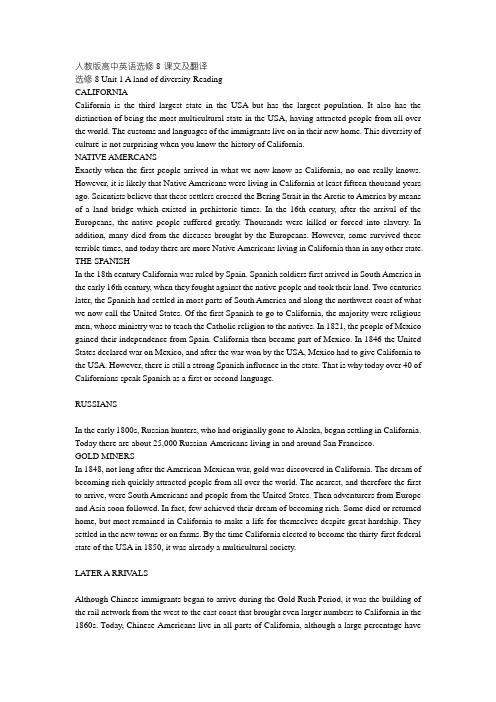
人教版高中英语选修8 课文及翻译选修8 Unit 1 A land of diversity-ReadingCALIFORNIACalifornia is the third largest state in the USA but has the largest population. It also has the distinction of being the most multicultural state in the USA, having attracted people from all over the world. The customs and languages of the immigrants live on in their new home. This diversity of culture is not surprising when you know the history of California.NA TIVE AMERCANSExactly when the first people arrived in what we now know as California, no one really knows. However, it is likely that Native Americans were living in California at least fifteen thousand years ago. Scientists believe that these settlers crossed the Bering Strait in the Arctic to America by means of a land bridge which existed in prehistoric times. In the 16th century, after the arrival of the Europeans, the native people suffered greatly. Thousands were killed or forced into slavery. In addition, many died from the diseases brought by the Europeans. However, some survived these terrible times, and today there are more Native Americans living in California than in any other state. THE SPANISHIn the 18th century California was ruled by Spain. Spanish soldiers first arrived in South America in the early 16th century, when they fought against the native people and took their land. Two centuries later, the Spanish had settled in most parts of South America and along the northwest coast of what we now call the United States. Of the first Spanish to go to California, the majority were religious men, whose ministry was to teach the Catholic religion to the natives. In 1821, the people of Mexico gained their independence from Spain. California then became part of Mexico. In 1846 the United States declared war on Mexico, and after the war won by the USA, Mexico had to give California to the USA. However, there is still a strong Spanish influence in the state. That is why today over 40 of Californians speak Spanish as a first or second language.RUSSIANSIn the early 1800s, Russian hunters, who had originally gone to Alaska, began settling in California. Today there are about 25,000 Russian-Americans living in and around San Francisco.GOLD MINERSIn 1848, not long after the American-Mexican war, gold was discovered in California. The dream of becoming rich quickly attracted people from all over the world. The nearest, and therefore the first to arrive, were South Americans and people from the United States. Then adventurers from Europe and Asia soon followed. In fact, few achieved their dream of becoming rich. Some died or returned home, but most remained in California to make a life for themselves despite great hardship. They settled in the new towns or on farms. By the time California elected to become the thirty-first federal state of the USA in 1850, it was already a multicultural society.LATER A RRIV ALSAlthough Chinese immigrants began to arrive during the Gold Rush Period, it was the building of the rail network from the west to the east coast that brought even larger numbers to California in the 1860s. Today, Chinese-Americans live in all parts of California, although a large percentage havechosen to stay in the "Chinatowns" of Los Angeles and San Francisco.Other immigrants such as Italians, mainly fishermen but also wine makers, arrived in California in the late 19th century. In 1911 immigrants from Denmark established a town of their own, which today still keeps up their Danish culture. By the 1920s the film industry was well established in Hollywood, California. The industry boom attracted Europeans including many Jewish people. Today California has the second largest Jewish population in the United States.Japanese farmers began arriving in California at the beginning of the 20th century, and since the 1980s a lot more have settled there. People from Africa have been living in California since the 1800s, when they moved north from Mexico. However, even more arrived between 1942 and 1945 to work in the ship and aircraft industries.MOST RECENT ARRIV ALSIn more recent decades, California has become home to more people from Asia, including Koreans, Cambodians, Vietnamese and Laotians. Since its beginning in the 1970s, the computer industry has attracted Indians and Pakistanis to California.THE FUTUREPeople from different parts of the world, attracted by the climate and the lifestyle, still immigrate to California. It is believed that before long the mix of nationalities will be so great that there will be no distinct major racial or cultural groups, but simply a mixture of many races and cultures. GEORGE’S DIARY 12TH—14TH JUNEMonday 12th, JuneArrived early this morning by bus. Went straight to hotel to drop my luggage, shower and shave. Then went exploring. First thing was a ride on a cable car. From top of the hill got a spectacular view of San Francisco Bay and the city. Built in 1873, the cable car system was invented by Andrew Hallidie, who wanted to find a better form of transport than horse-drawn trams. Apparently he'd been shocked when he saw a terrible accident in which a tram's brakes failed, the conductor could not control the situation and the tram slipped down the hill dragging the horses with it.Had a late lunch at Fisherman's What. This is the district where Italian fishermen first came to San Francisco in the late 19th century and began the fishing industry. Now it's a tourist area with lots of shops, sea food restaurants and bakeries. It's also the place to catch the ferry to Angel Island and other places in the Bay.Did so much exploring at Fisherman's What. Am exhausted and don't feel like doing anything else. Early bed tonight!Tuesday 13th, JuneTeamed up with a couple from my hotel (Peter and Terri) and hired a car. Spent all day driving around the city. There's a fascinating drive marked out for tourists. It has blue and white signs with seagulls on them to show the way to go. It's a 79km round-trip that takes in all the famous tourist spots. Stopped many times to admire the view of the city from different angles and take photographs. Now have a really good idea of what the city's like.In evening, went to Chinatown with Peter and Terri. Chinese immigrants settled in this area in the 1850s. The fronts of the buildings are decorated to look like old buildings in southern China. Saw some interesting temples here, a number of markets and a great many restaurants. Also art galleriesand a museum containing documents, photographs and all sorts of objects about the history of Chinese immigration, but it is closed in the evening. Will go back during the day. Had a delicious meal and then walked down the hill to our hotel.Wednesday 14th, JuneIn morning, took ferry to Angel Island from the port in San Francisco Bay. On the way had a good view of the Golden Gate Bridge. From 1882 to 1940 Angel Island was a famous immigration station where many Chinese people applied for right to live in USA. The cells in the station were very small, cold and damp; some did not even have light but the immigrants had nowhere else to go. Their miserable stay seemed to be punishment rather than justice and freedom to them. They wrote poems on the walls about their loneliness and mourned their former life in China. In 1940 the civil authorities reformed the system so that many more Chinese people were able to grasp the opportunity of settling in the USA. Made me very thoughtful and thankful for my life today.选修8 Unit 2 Cloning-ReadingCLONING: WHERE IS IT LEADING USCloning has always been with us and is here to stay. It is a way of making an exact copy of another animal or plant. It happens in plants when gardeners take cuttings from growing plants to make new ones. It also happens in animals when twins identical in sex and appearance are produced from the same original egg. The fact is that these are both examples of natural clones.Cloning has two major uses. Firstly, gardeners use it all the time to produce commercial quantities of plants. Secondly, it is valuable for research on new plant species and for medical research on animals. Cloning plants is straightforward while cloning animals is very complicated. It is a difficult task to undertake. Many attempts to clone mammals failed. But at last the determination and patience of the scientists paid off in 1996 with a breakthrough - the cloning of Dolly the sheep. The procedure works like this:On the one hand, the whole scientific world followed the progress of the first successful clone, Dolly the sheep. The fact that she seemed to develop normally was very encouraging. Then came the disturbing news that Dolly had become seriously ill. Cloning scientists were cast down to find that Dolly's illnesses were more appropriate to a much older animal. Altogether Dolly lived six and a half years, half the length of the life of the original sheep. Sadly the same arbitrary fate affected other species, such as cloned mice. The questions that concerned all scientists were: "Would this be a major difficulty for all cloned animals Would it happen forever Could it be solved if corrections were made in their research procedure"On the other hand, Dolly's appearance raised a storm of objections and had a great impact on the media and public imagination. It became controversial. It suddenly opened everybody's eyes to the possibility of using cloning to cure serious illnesses and even to produce human beings.Although at present human egg cells and embryos needed for cloning research are difficult to obtain, newspapers wrote of evil leaders hoping to clone themselves to attain their ambitions. Religious leaders also raised moral questions. Governments became nervous and more conservative. Some began to reform their legal systems and forbade research into human cloning, but other countries like China and the UK, continued to accumulate evidence of the abundant medical aid that cloningcould provide. However, scientists still wonder whether cloning will help or harm us and where it is leading us.克隆一直在我们左右并且已经被大多数人接受。
高中英语选修8课文逐句翻译(人教版)
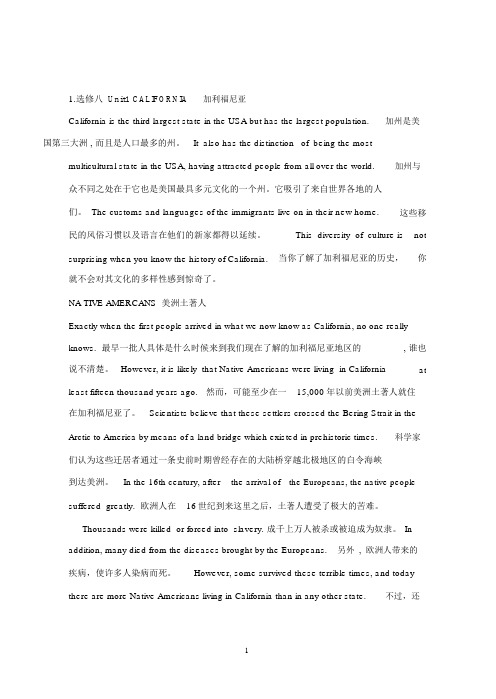
1.选修八Unit1 CALIFORNIA加利福尼亚California is the third largest state in the USA but has the largest population.加州是美国第三大洲 , 而且是人口最多的州。
It also has the distinction of being the most multicultural state in the USA, having attracted people from all over the world.加州与众不同之处在于它也是美国最具多元文化的一个州。
它吸引了来自世界各地的人们。
The customs and languages of the immigrants live on in their new home.这些移民的风俗习惯以及语言在他们的新家都得以延续。
This diversity of culture is not surprising when you know the history of California.当你了解了加利福尼亚的历史,你就不会对其文化的多样性感到惊奇了。
NA TIVE AMERCANS 美洲土著人Exactly when the first people arrived in what we now know as California, no one reallyknows. 最早一批人具体是什么时候来到我们现在了解的加利福尼亚地区的, 谁也说不清楚。
However, it is likely that Native Americans were living in California at least fifteen thousand years ago.然而,可能至少在一15,000年以前美洲土著人就住在加利福尼亚了。
Scientists believe that these settlers crossed the Bering Strait in the Arctic to America by means of a land bridge which existed in prehistoric times.科学家们认为这些迁居者通过一条史前时期曾经存在的大陆桥穿越北极地区的白令海峡到达美洲。
高中英语选修八课文及翻译

高中英语选修八课文及翻译选修8Unit1Alandofdiversity-ReadingCALIFORNIACaliforniaisthethirdlargeststateintheUSAbuthasthelargestpo pulation.Italsohasthedistinctionofbeingthemostmulticulturalstat eintheUSA,havingattractedpeoplefromallovertheworld.Thecusto msandlanguagesoftheimmigrantsliveonintheirnewhome.Thisdiv ersityofcultureisnotsurprisingwhenyouknowthehistoryofCaliforni a.Unit1加利福尼亚加利福尼亚是美国的第三大州,而且是人口最多的州。
加州与众不同之处在于它也是美国最具多元文化的一个州,它吸引了来自世界各地的人们。
这些移民的风俗习惯以及语言在他们的新家都得以延续。
当你了解了加利福尼亚的历史后,你就不会对此感到惊讶了。
NATIVEAMERCANSExactlywhenthefirstpeoplearrivedinwhat wenowknowasCalifornia,noonereallyknows.However,itislikelytha tNativeAmericanswerelivinginCaliforniaatleastfifteenthousandye arsago.ScientistsbelievethatthesesettlerscrossedtheBeringStraiti ntheArctictoAmericabymeansofalandbridgewhichexistedinprehi storictimes.Inthe16thcentury,afterthearrivaloftheEuropeans,then ativepeoplesufferedgreatly.Thousandswerekilledorforcedintosla very.Inaddition,manydiedfromthediseasesbroughtbytheEuropea ns.However,somesurvivedtheseterribletimes,andtodaytherearem oreNativeAmericanslivinginCaliforniathaninanyotherstate.美洲土著人最早的一批人具体是在什么时候来到我们现在所知道的加利福尼亚地区的,谁也说不清楚。
人教版高中英语选修8课文与翻译
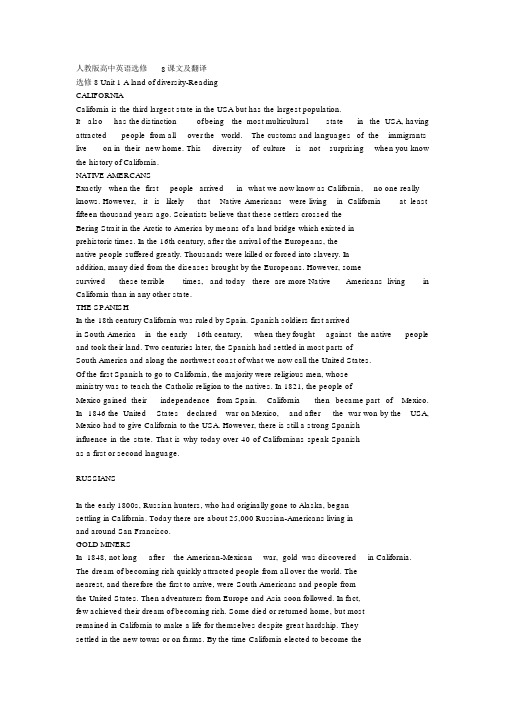
人教版高中英语选修8课文及翻译选修 8 Unit 1 A land of diversity-ReadingCALIFORNIACalifornia is the third largest state in the USA but has the largest population.It also has the distinction of being the most multicultural state in the USA, having attracted people from all over the world.The customs and languages of the immigrants live on in their new home. This diversity of culture is not surprising when you know the history of California.NATIVE AMERCANSExactly when the first people arrived in what we now know as California,no one really knows. However,it is likely that Native Americans were living in California at least fifteen thousand years ago. Scientists believe that these settlers crossed theBering Strait in the Arctic to America by means of a land bridge which existed inprehistoric times. In the 16th century, after the arrival of the Europeans, thenative people suffered greatly. Thousands were killed or forced into slavery. Inaddition, many died from the diseases brought by the Europeans. However, somesurvived these terrible times,and today there are more Native Americans living in California than in any other state.THE SPANISHIn the 18th century California was ruled by Spain. Spanish soldiers first arrivedin South America in the early16th century,when they fought against the native people and took their land. Two centuries later, the Spanish had settled in most parts ofSouth America and along the northwest coast of what we now call the United States.Of the first Spanish to go to California, the majority were religious men, whoseministry was to teach the Catholic religion to the natives. In 1821, the people ofMexico gained their independence from Spain.California then became part of Mexico. In1846 the United States declared war on Mexico,and after the war won by the USA, Mexico had to give California to the USA. However, there is still a strong Spanishinfluence in the state. That is why today over 40 of Californians speak Spanishas a first or second language.RUSSIANSIn the early 1800s, Russian hunters, who had originally gone to Alaska, begansettling in California. Today there are about 25,000 Russian-Americans living inand around San Francisco.GOLD MINERSIn 1848, not long after the American-Mexican war, gold was discovered in California.The dream of becoming rich quickly attracted people from all over the world. Thenearest, and therefore the first to arrive, were South Americans and people fromthe United States. Then adventurers from Europe and Asia soon followed. In fact,few achieved their dream of becoming rich. Some died or returned home, but mostremained in California to make a life for themselves despite great hardship. Theysettled in the new towns or on farms. By the time California elected to become thethirty-first federal state of the USA in 1850, it was already amulticultural society.LATER A RRIVALSAlthough Chinese immigrants began to arrive during the Gold Rush Period,it was the building of the rail network from the west t o the east coast that brought even larger numbers to California in the 1860s. Today, Chinese-Americans live in all parts ofCalifornia,although a large percentage have chosen to stay in the"Chinatowns"of Los Angeles and San Francisco.Other immigrants such as Italians, mainly fishermen but also wine makers, arrivedin California in the late 19th century.In1911 immigrants from Denmark established a town of their own, which today still keeps up their Danish culture. By the 1920sthe film industry was well established in Hollywood,California.The industry boom attracted Europeans including many Jewish people. Today California has the secondlargest Jewish population in the United States.Japanese farmers began arriving in California at the beginning of the 20th century, and since the1980s a lot more have settled there.People from Africa have been living in California since the1800s,when they moved north from Mexico.However, even more arrived between 1942 and 1945 to work in the ship and aircraft industries.MOST RECENT ARRIVALSIn more recent decades,California has become home to more people from Asia, including Koreans, Cambodians, Vietnamese and Laotians.Since its beginning in the 1970s, the computer industry has attracted Indians and Pakistanis to California.THE FUTUREPeople from different parts of the world,attracted by the climate and the lifestyle,still immigrate to California.It is believed that before long the mix of nationalities will be so great that there will be no distinct major racial or cultural groups, but simply a mixture of many races and cultures.GEORGE’S DIARY 12TH— 14TH JUNEMonday 12th, JuneArrived early this morning by bus.Went straight to hotel to drop my luggage,shower and shave. Then went exploring. First thing was a ride on a cable car. From top ofthe hill got a spectacular view of San Francisco Bay and the city. Built in 1873,the cable car system was invented by Andrew Hallidie, who wanted to find a betterform of transport than horse-drawn trams.Apparently he'd been shocked when he saw a terrible accident in which a tram's brakes failed,the conductor could not control the situation and the tram slipped down the hill dragging the horses with it.Had a late lunch at Fisherman's What. This is the district where Italian fishermenfirst came to San Francisco in the late19th century and began the fishing industry. Now it's a tourist area with lots of shops,sea food restaurants and bakeries.It's also the place to catch the ferry to Angel Island and other places in the Bay.Did so much exploring at Fisherman's What. Am exhausted and don't feel likedoing anything else. Early bed tonight!Tuesday 13th, JuneTeamed up with a couple from my hotel (Peter and Terri) and hired a car. Spent allday driving around the city. There's a fascinating drive marked out for tourists.It has blue and white signs with seagulls on them to show the way to go. It's a 79km round-trip that takes in all the famous tourist spots.Stopped many times to admire the view of the city from different angles and take photographs. Now have a reallygood idea of what the city's like.In evening, went to Chinatown with Peter and Terri. Chinese immigrants settled inthis area in the 1850s. The fronts of the buildings are decorated to look like oldbuildings in southern China.Saw some interesting temples here, a number of markets and a great many restaurants.Also art galleries and a museumcontaining documents, photographs and all sorts of objects about the history of Chinese immigration,but it is closed in the evening. Will go back during the day. Had a delicious meal andthen walked down the hill to our hotel.Wednesday 14th, JuneIn morning, took ferry to Angel Island from the port in San Francisco Bay. On theway had a good view of the Golden Gate Bridge. From 1882 to 1940 Angel Islandwas a famous immigration station where many Chinese people applied for right to livein USA. The cells in the station were very small, cold and damp; some did not evenhave light but the immigrants had nowhere else to go. Their miserable stay seemedto be punishment rather than justice and freedom to them. They wrote poems on thewalls about their loneliness and mourned their former life in China. In 1940 the civilauthorities reformed the system so that many more Chinese people were ableto grasp the opportunity of settling in the USA. Made me very thoughtful and thankful for my life today.选修 8 Unit 2 Cloning-ReadingCLONING: WHERE IS IT LEADING US?Cloning has always been with us and is here to stay. It is a way of making an exactcopy of another animal or plant. It happens in plants when gardeners take cuttings from growing plants to make new ones. It also happens in animals when twins identicalin sex and appearance are produced from the same original egg. The fact is that these are both examples of natural clones.Cloning has two major uses. Firstly, gardeners use it all the time to producecommercial quantities of plants.Secondly,it is valuable for research on new plant species and for medical research on animals.Cloning plants is straightforward while cloning animals is very complicated. It is a difficult task to undertake. Manyattempts to clone mammals failed.But at last the determination and patience of the scientists paid off in 1996 with a breakthrough - the cloning of Dolly the sheep.The procedure works like this:On the one hand, the whole scientific world followed the progress of the firstsuccessful clone,Dolly the sheep.The fact that she seemed to develop normally was very encouraging.Then came the disturbing news that Dolly had become seriously ill. Cloning scientists were cast down to find that Dolly's illnesses were more appropriate to a much older animal. Altogether Dolly lived six and a half years,half the length of the life of the original sheep. Sadly the same arbitrary fateaffected other species, such as cloned mice. The questions that concerned allscientists were: "Would this be a major difficulty for all cloned animals? Wouldit happen forever? Could it be solved if corrections were made in their researchprocedure?"On the other hand, Dolly's appearance raised a storm of objections and had a greatimpact on the media and public imagination. It became controversial. It suddenlyopened everybody's eyes to the possibility of using cloning to cure serious illnesses and even to produce human beings.Although at present human egg cells and embryos needed for cloning research aredifficult to obtain, newspapers wrote of evil leaders hoping to clone themselvesto attain their ambitions.Religious leaders also raised moral questions. Governments became nervous and more conservative.Some began to reform their legal systems and forbade research into human cloning,but other countries like China and the UK, continued to accumulate evidence of the abundant medical aid that cloningcould provide. However, scientists still wonder whether cloning will help or harmus and where it is leading us.克隆一直在我们左右并且已经被大多数人接受。
- 1、下载文档前请自行甄别文档内容的完整性,平台不提供额外的编辑、内容补充、找答案等附加服务。
- 2、"仅部分预览"的文档,不可在线预览部分如存在完整性等问题,可反馈申请退款(可完整预览的文档不适用该条件!)。
- 3、如文档侵犯您的权益,请联系客服反馈,我们会尽快为您处理(人工客服工作时间:9:00-18:30)。
选修8Unit 1 大课文多样性的土地加州加州是美国第三大洲,但是人口最多。
它也有不同的是最多元文化国家在美国,有吸引了来自世界各地的人们。
的习俗和语言的移民活在新居。
这个文化多样性并不令人惊讶当你知道他的历史加州。
本土美国人什么时候到的第一批人我们现在知道的加利福尼亚,没有人真的知道。
然而,很可能在加利福尼亚居住美国印地安人是至少一万五千年前。
科学家们认为这些定居者穿过白令海峡在北极到美国的一种方法中存在的陆地桥在史前时期。
在16世纪,欧洲人到来之后,当地人中蒙受了重大损失。
数千人的死亡或被迫成为奴隶。
另外,许多人死于这种疾病所带来的欧洲人。
然而,从一些这些可怕的时代,今天还有更多的美国人住在加州比任何其他国家。
西班牙在18世纪,加州被西班牙。
名西班牙士兵初到南美洲,在16世纪早期当他们攻打当地人,把他们的土地。
两个世纪以后,西班牙人定居在大部分南美和沿西北海岸的我们现在所称的美国。
第一个西班牙去加州,大多数都是虔诚的教徒。
他们的部门是要教导天主教给当地人。
1821年,墨西哥取得了他们的从西班牙独立。
加州的一部分则成了墨西哥。
1846年美国宣战墨西哥和战争结束后获美国、墨西哥不得不给加州到美国。
然而,仍有强烈的西班牙影响国家。
这就是为什么今天超过40的加州人说西班牙语作为第一或第二语言。
俄罗斯人在19世纪初,俄罗斯的猎人,这些原本,开始去阿拉斯加定居在加州。
在那里的今天是大约2.5万美籍俄裔住在旧金山市区和郊区。
黄金生产商1848年1月24日,美墨战争后不久,有人在加州发现了黄金。
快速致富的梦想吸引了来自世界各地的人们。
最近的,因此第一个到达,是来自美国人民和来自美国。
然后从欧洲和亚洲的冒险者随之而来。
事实上,一些达到了他们的梦想成为富足。
一些死亡或回到家,但是大多数住在加利福尼亚使自己的生活不顾大的困难。
他们就住在新城镇或在农场工作。
在加州成为31日当选美国的联邦州在1850年,已经是一个多元文化的社会。
晚来者尽管中国移民开始到在淘金热期间,他们的建筑……(文件丢失)从西方的铁路网络到东海岸带来了更大的编号到加州十九世纪六十年代。
今天,美藉华人住在加州的所有部分,尽管大部分选择呆在“唐人街”的洛杉矶和旧金山。
意大利人等其他移民,主要渔民还酿酒师,到达了加州在十九世纪。
在1911年移民建立了镇来自丹麦的自己,今天仍然继续他们的丹麦文化。
到了二十世纪二十年代电影产业被确立在美国加利福尼亚州的好莱坞。
因此本行业的繁荣——吸引了欧洲人包括许多犹太民族主义者。
加州第二大今天犹太人口在美国。
日本的农民就已来到加利福尼亚在20世纪初,自20世纪80年代以来很多都在此定居。
人们从非洲一直住在加州自19世纪以来(北移动时,来自墨西哥。
然而更到1942年到1945年之间在船上工作和航空工业。
最近的人数在最近几十年,加州有成为家里更多的人来自亚洲,包括韩国人、柬埔寨人、越南和老挝人和。
从它开始在20世纪70年代,计算机工业吸引了印度人和巴勒斯坦人到加州来。
未来来自世界不同区域的人们在气候和吸引的生活方式,还移民到加州来。
人们相信,在长混合民族会相当大,将有不具有明显的主要的民族和文化团体,只是不同种族和文化的混合物。
小课文GEORGE’S DIARY 12TH—14TH JUNE乔治的日记6月12日,星期一今天早晨到达乘公共汽车去。
径直走到酒店掉我的行李,淋浴和刮胡子。
然后去探索。
首先是一个骑一匹电缆车。
从山顶上,得到了一个引人入胜的景观的旧金山海湾和这个城市。
建立1873年,缆车系统由安德鲁赶紧发明,他想找一份更好的形式的交通比坐在弯折。
显然,他很震惊,这时他看见了一起可怕的事故中,电车的刹车、导体不能控制的情况和电车滑下山坡马拖着。
有一晚中午在渔夫是什么。
这是该地区在意大利渔民第一次来到旧金山在19世纪末,开始渔业的发展。
现在是一个旅游地区很多商店,海鲜餐馆和面包店。
这也是地方赶上渡轮天使岛和其他地方湾的。
在探索做了那么多的渔人什么。
太累了,也别想做的任何东西。
早期今晚床!6月13日,星期二和一对从我的酒店(彼得和特里)和租了一辆汽车。
一整天都在推动全国各地的城市。
有一个吸引人的驱动显示出在游客。
它有蓝色和白色海鸥的标志,但在他们出示路要走。
这是一个79km往返,将所有著名的旅游景点。
停止许多次,欣赏眼前的景色的城市从不同的角度和拍照。
现在有一个很好的主意的那个城市是什么样子。
傍晚,去唐人街彼得和特里。
中国移民定居在这个地区18世纪50年代。
穿越战线装饰的建筑物都看起来像旧建筑在中国南部。
看到一些有趣的庙宇在这里,大量的市场和许多餐馆。
也美术馆和博物馆包含文本、图片和各种各样的物体的中国移民的历史,但它是关闭的晚上。
要回去在白天。
了美味的一餐然后步行下山来我们酒店。
6月14日,星期三在上午,作为渡轮天使岛的港口在旧金山海湾。
在有一个好的视野的金门桥。
从1882年到1940年天使岛是一位著名的移民站在哪里许多中国个人申请生存权利在美国。
这些细胞在车站很小,寒冷和潮湿,有些甚至没有光,但移民没有别的地方可去。
他们的悲惨的保持似乎而不是正义和自由的惩罚。
他们在墙上写诗对他们的孤独和悼念他们的前任在中国的生活。
1940年中国政府改革的各项制度,使更多的中国人,人们能把握机遇解决在美国。
让我非常体贴和感谢我的人生。
选修8 Unit 2 Cloning-Reading克隆:在哪里带领我们吗?克隆会始终伴随着我们,停在这里。
它是一种使一个精确的拷贝另一动物或植物。
它发生在植物生长当园丁把扦插植物结交新朋友。
它也发生在动物当双胞胎相同的性和外观很由同一原始蛋。
事实上,这些都是例子的自然的复制。
克隆有两大主要用途。
首先,园丁使用它产生商业价值的植物。
其次,它是很有用的,为研究新植物和动物为医学研究。
克隆植物克隆动物是简单的,是很复杂的。
这是个艰难的任务,进行。
多次试图克隆哺乳动物失败了。
但最后,决心和耐心的科学家一次性付清1996年突破-克隆多利羊。
过程是这样:一方面,整个科学界进步之后的第一个成功克隆,多利羊。
这样的事实:她似乎正常发展是很令人鼓舞的。
之后出现了令人不安的消息,多利已经病得很重。
克隆科学家发现被摔下去多利的疾病更适用于更古老的动物。
共朵莉住6年半,长度的一半生命的原始的羊。
不幸的是同样的任意的命运影响其他物种,例如克隆老鼠。
有关的问题,科学家们:“这是一个很大的困难,所有的克隆动物吗?它会发生到永远吗?如果修正它能解决在他们的研究过程吗?”另一方面,多莉的出现了风暴的反对,有着极大的影响媒体和公众的想像力。
它成为争议。
它突然打开每个人的眼睛里的可能利用克隆技术来治疗严重疾病,甚至产生人类。
虽然目前人类卵子和胚胎克隆研究需要也难取得、报纸写了邪恶的领导人希望克隆自己达到他们的野心。
宗教领袖也提高了道德问题。
政府变得紧张,更保守。
一些开始改革研究法律制度、禁止人类克隆,但是其他国家如中国和英国,不断积累的证据表明丰医疗援助,克隆所能够提供的。
然而,科学家仍不知道克隆将会帮助或伤害我们和在哪里带领我们。
小课文:恐龙回归?他们可能会克隆激烈,灭绝的野生动物一直兴奋电影制作人。
他们不是唯一!的受欢迎程度的电影如《侏罗纪公园》,在这一过程中,科学家克隆几种灭绝恐龙,证明他是多麽的想法混合了恐惧和激动人心。
但事实上,我们还有很长的路要能够克隆灭绝的动物。
科学家仍试验克隆哺乳动物。
这是因为克隆哺乳动物仍然是一个新的科学与它的故事只有开始严重在20世纪50年代,因为这名单显示:20世纪50年代克隆青蛙1996年第一次复制哺乳动物:多利羊20世纪70年代的老鼠的胚胎论文以2000母牛生了一个野牛1979年工作的羊和小鼠胚胎2001年中国第一个克隆的双胞胎的小牛1981年,发明首个克隆的实验小鼠第一只克隆猫2002年1983年克隆的第一个实验牛2005年第一次克隆狗…有时,人们建议绝种动物,像恐龙,可能带回生活通过克隆。
不幸的是,我们现在所知道的,这不是不可能或不适合。
有许多原因。
◎最初的要求是你需要完美的DNA(提供信息,为细胞是如何要想长)。
◎克隆动物的一切努力都是徒劳的,如果没有足够的多样性克服集团疾病。
在一组多样性手段在他们的基因动物以多种方法来安排。
好处是如果有一个新的疾病这些动物之中,可死,但是其他人会幸存,并且把这个疾病的抵抗能力给下一代。
克隆的最大缺点的一组他们都将动物的基因有相同的安排,所以可能会死相同的疾病。
然后他们谁都不愿意将左继续物种。
◎是不公平的任何绝种动物克隆如果他们能够生活在一个动物园里。
需要合适的栖身之所过一种自然的生活。
基于我们现在所知道的,你不能克隆已经灭绝的动物,它们比一万年。
事实上,恐龙消失了6.5亿年前。
所以恐龙的机会回到地球的仅仅是一个梦。
选修8发明家和他们的发明大课文:蛇的问题当我打电话给我的妈妈在电话上的乡村她很恼火。
“有一些蛇在我们的院子里,”她告诉我。
“蛇挨近家现在然后,他们似乎把自己的家在这里,胡桃树的不远处。
你能摆脱他们吗?”我感到非常骄傲。
这是一个机会,让.me辨别自己创造一些新奇事物仁慈的,就会赶上蛇但是不会有害。
我知道我的父母不喜欢我伤害这些生物!我做的第一件事是,看是否有产品,可能会帮助我,但只有似乎粉设计杀死蛇。
明确需要了一种新的方法。
我蛇的习惯的研究发现最容易诱捕。
幸运的是这些爬虫类动物是小的解决方案,这使得更容易。
准备一些研究结果,我决定:首先,3种可能的方法;其次,消除其栖息地的圈套吸引他们使用的男性或女性的香水或食物;第三冷却他们,叫他们成为困的时候,可以轻易地抓住。
我决定用最后一场。
我买了一个冰淇淋制造商是不锈钢做的。
内部和外部之间的墙壁上有一些碗果冻,冻结在冷却过程中。
我把碗倒在冰箱里,等待24小时。
与此同时,我准备了一些冰块。
第二天早上我起了个大早面前对着日头很热。
我把冷冻碗在蛇的栖息地和冰块在上面的碗保持凉爽。
最后我覆盖了整个一桶大的东西。
然后等待。
两小时后我把桶,盘子里的那个人。
蛇是不活跃,但他们仍然跑得太快了。
他们突然消失在一个方便的墙壁的洞。
所以我必须调整我的计划。
为第二次我僵住了一个大盆,把他们的冰块一次,但在蛇的栖息地在晚上,温度开始酷。
然后像以前一样,把盆里遮盖的桶,把所有的东西都过夜。
第二天一早,我回到看到结果。
这次是在伟大的小心我弯腰检查蛇,我发现他们很困了。
但是一旦捡起,他们就试图咬我。
他们有毒的蛇,我清楚地需要改进我的设计了。
我的第三个尝试重复第二程序。
第二天早上我进行的,在我的手一个小网的用于钓到鱼。
这是在期盼蛇会咬人了。
但仔细监测,蛇就被证明是没有什么烦恼,一切都是按照计划。
我收集被动蛇和第二天我们欢欢喜喜地释放了他们所有的回山野。
我的朋友和亲戚追问下,我决定抓住机遇,受到肯定我成功的观念被派我的发明专利办公室。
